Paris Metro Guide
Navigating Paris by metro can seem like a daunting task, even before you throw in a foreign language, numerous metro lines, and a confusing ticketing system. As a frequent traveler to Paris, I’ve often gotten it wrong and walked way more than I should while exploring Paris! Alas, this blog is called Misadventures with Andi for a reason!
BUT, you can do it! It is an inexpensive and effective way to get around Paris.
Some posts on this site contain affiliate links, meaning if you book or buy something through one of these links, I may earn a small commission (at no extra cost to you!). Opinions are always my own and I’ll never promote something I don’t use or believe in. Also as an Amazon Associate I earn from qualifying purchases.
The extensive metro system network and underground railway system can leave you overwhelmed if you’re not well-equipped. I’ve compiled all my experiences into this guide for using the metro in Paris in the hopes that your experience is as hassle-free as possible.
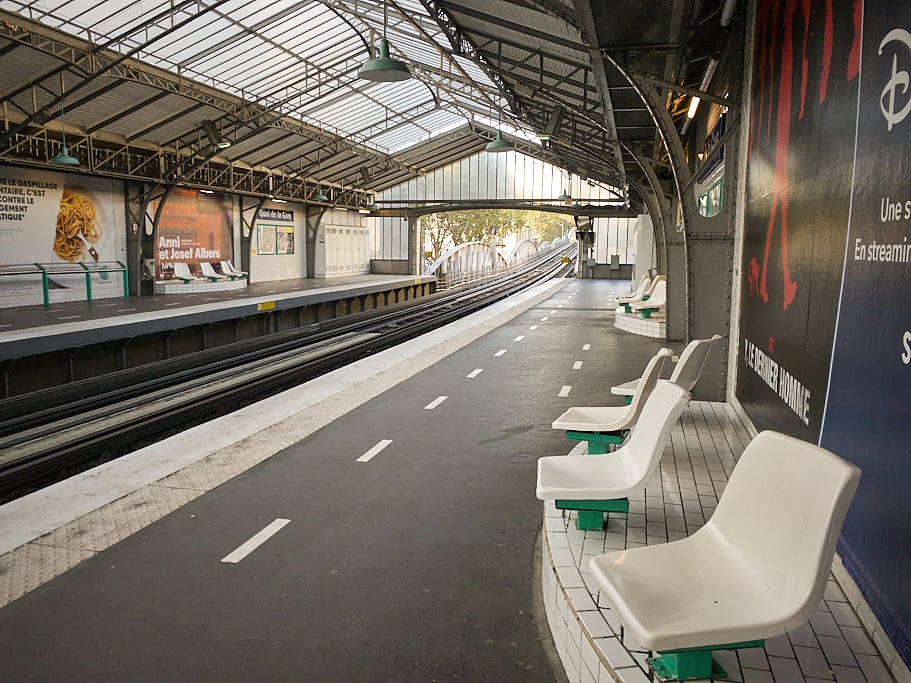
How to use the Paris Métro?
The metro has been providing an efficient, affordable, and environmentally friendly way to get around Paris for a very long time and it remains a vital part of daily life in this city. If you're planning a trip to Paris, learning how to use the Métro is a necessity. It's actually quite simple and straightforward once you get the hang of it.
Learning the Metro system
When traveling in Paris, chances are you’re not too far away from a metro station. It’s a good idea to learn how the Paris subway works, as it is the fastest way to cross the city. The metros run from around 05:30 am until about 01:15 am (and until 2 am on Fridays and Saturdays). The trains are quite frequent, and even more during the rush hours, which range from 08:30-09:30 am and 05:30-07:30 pm.
You simply have to look up to see when the next train is!
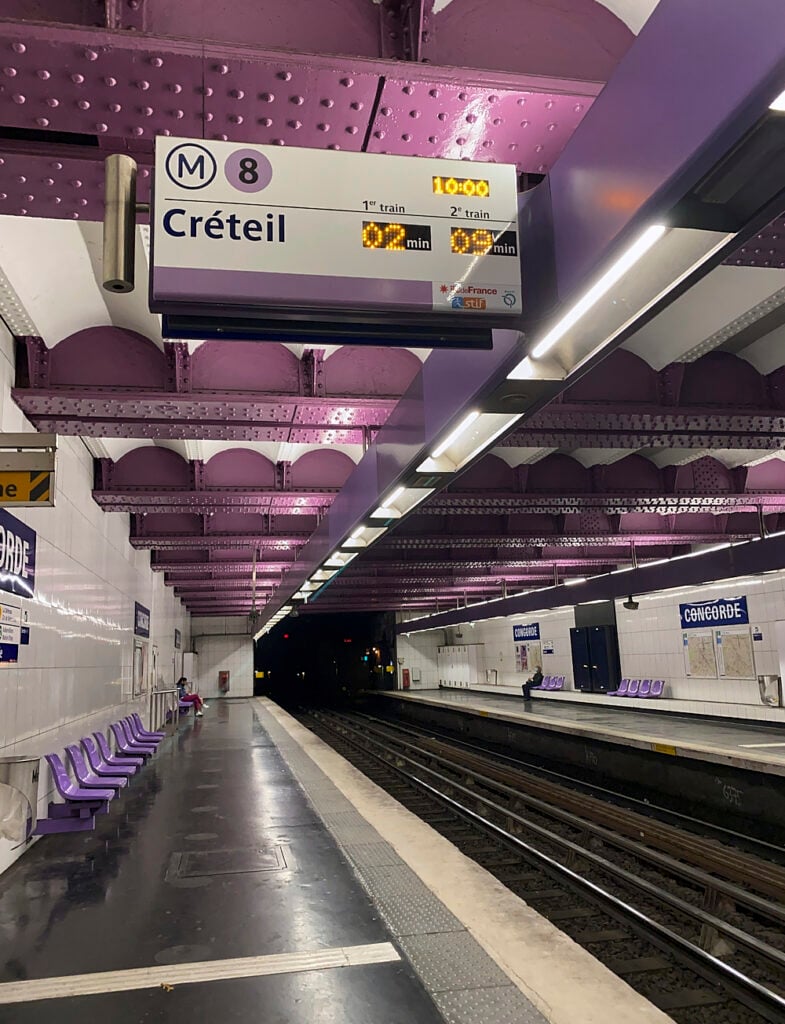
The Paris Métro doesn’t run through the night (they need to be cleaned at some point!) If you need to travel, there are night buses from the major RER stations in Paris (Châtelet, Gare de l’Est, Gare de Lyon, Gare Saint-Lazare, and Montparnasse).
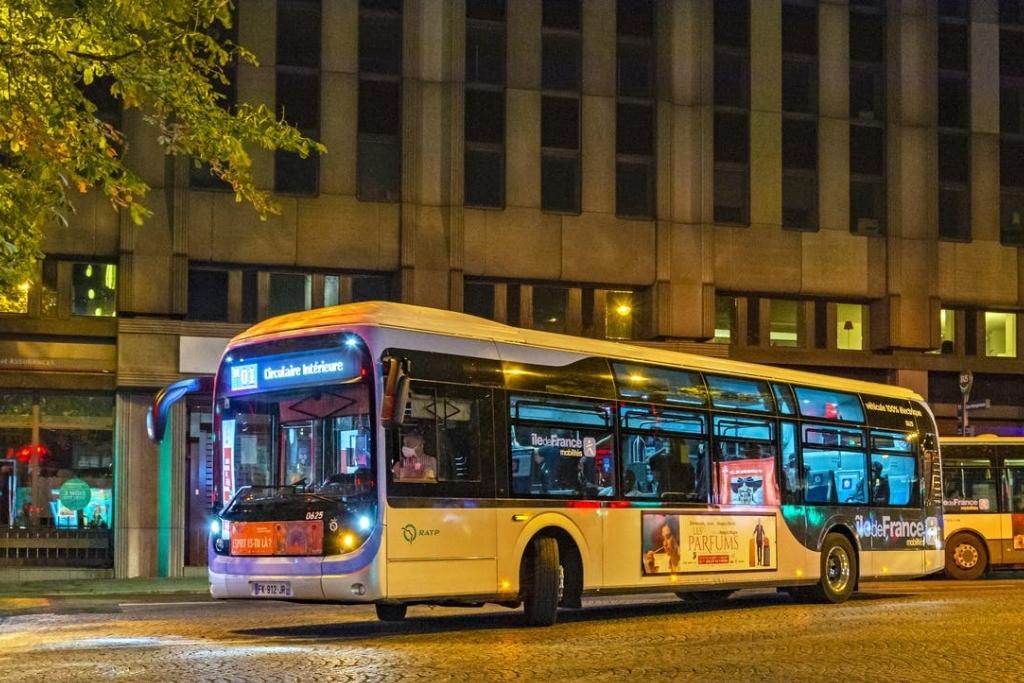
The transport system divides Paris and its suburbs into different zones. Paris is zone 1, and the suburbs range from zone 2-4. A few metro lines run in zone 2 and 3, but almost all of them are stationed in zone 1.
In the city center, the underground system also caters to the RER lines, so be careful. The Paris metro lines are marked with a capital “M”. While the price of the metro ticket stays the same, the prices differ once you use the RER to travel in zones 2-4. If your originating station and the destination RER station are both located in zone 1, the ticket rate is the same as the metro ticket rate.

The metro lines are labeled by a number and color, but it is more common to use the number when referring to a line.
We used to walk around with our pocket-sized maps of the metro lines. We would peer at it trying to find the station and then follow our fingers to figure out the 2 termini, but nowadays we use an app! It figures out everything for us without hurting our brains!

NOTE: Although this app CAN be used offline, using apps outside the US require data on your cell phone. Plan accordingly with your cell phone provider. If you own your phone, then think about buying a sim card for Europe (we buy ours from Amazon) to use while you are in Paris.
The Paris Métro map is available within all metros and on the stations. There is a PDF version of the Paris metro map is also available on the metro website.

What is important is to know the 2 termini (endpoints) of the line. Especially when you need to do a transfer. All the signs indicating which direction of the line you are trying to find will be by their terminus.
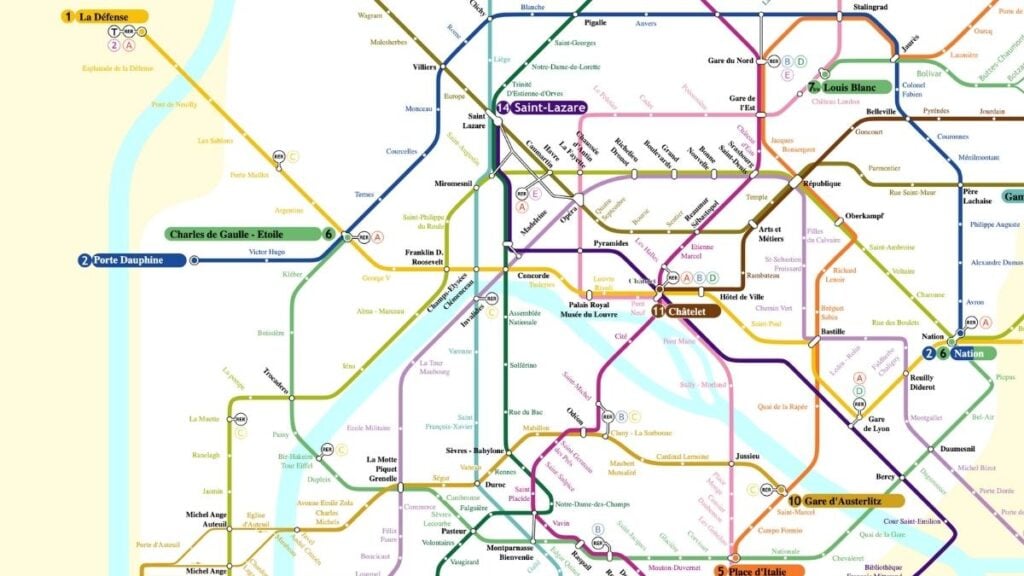
For example: You are visiting the Tuileries Garden and decide you want to get that perfect Insta-worthy shot of the Eiffel Tower framed by the metro window on the way to Bir Hakeim bridge.
Metro Tuileries (Line 1) —> Metro Bir-Hakeim (Line 6)

- You look at your app (the app has geo location in case you aren't sure where the closest station is) or look at a map and find yourself near the Tuileries metro stop on Line 1.
- Verify what are the termini for the line. For Line 1 they are La Défense and Château de Vincennes.
- You next locate the stop you want to go to, in this case, Bir Hakeim on Line 6.
- Next, you need to find where Line 1 and Line 6 intersect and find/ensure there is an “open” circle where you can transfer.
- Verify what are the termini for the line you are transferring to. For Line 6 they are Charles de Gaulle – Étoile and Nation.
- Find the terminus for Line 6 in the direction of Bir Hakeim, in this case, the direction is Nation.
- Get on Line 1 at the Tuileries metro stop in the direction of the terminus that intersects with Line 6. In this case, the direction is La Défense.
- Get off at your transfer station, in this case, it is Charles de Gaulle – Étoile (which also happens to be the terminus).
- Get on Line 6 direction Nation until you reach the Bir Hakeim station.

Et Voilà! You got the shot!

Travel photography
Best Spots Eiffel Tower Photos Ebook
Are you looking for the best spots to take a stunning Eiffel Tower photo in Paris? Look no further! This ebook is designed to be your one-stop guide for taking those breathtaking Eiffel Tower shots throughout the city.
An app will do all this calculating for you, but it is best to practice using a map as well!
Some stations have a neighborhood map showing the different exits (sortie). Once you know what exit you need follow the numbered sortie sides to ensure you exit the metro station in the area you want.

Inside the trains themselves (over the door), there is also a sign to check out all the stops on that line.
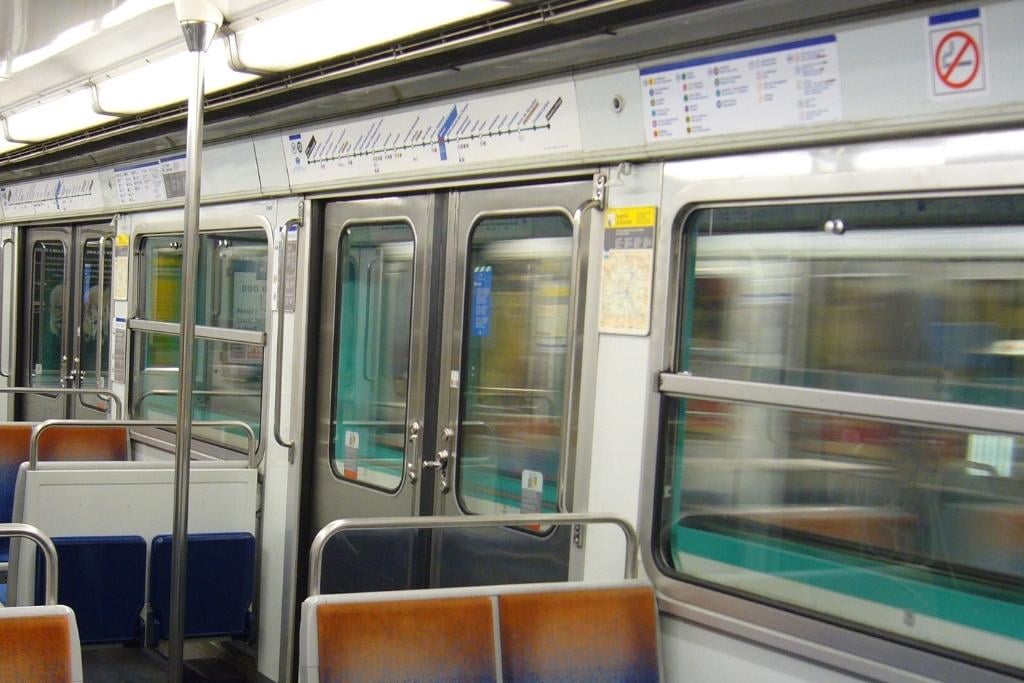
The stations are marked with two kinds of circles- the open circles are for stations where you can transfer to another line while the closed circle has no corresponding lines (therefore, no transfers).

While the metro is easy and efficient, the stations are filled with long hallways and lots of stairs. Most of the metro stations have either an escalator or an elevator (which are often not working) but there are quite a few that only have the traditional stairs.
So if you have a lot of luggage and your metro station is not popular or has no transfers, chances are you’ll have to carry your bags up and down the stairs.
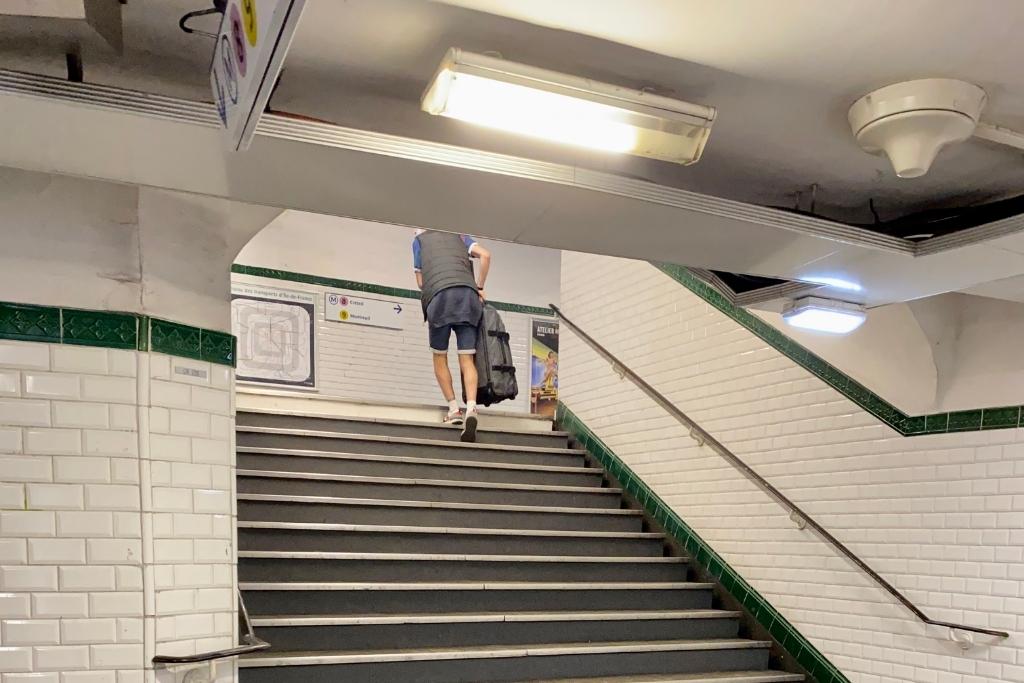
Purchasing tickets for the Paris Métro
There are a few types of tickets available, so it’s crucial to know where you’re going as a tourist. The most common type is the single-use ticket. As the name suggests, the ticket can be used for one journey. It is called the “t+” ticket and allows you to use the métro, the bus, the tram, the Montmartre funicular, and the RER within Paris.

It is a cardboard ticket, each costing €1.90. The tickets can be bought at the metro, RER, and tram stations. Bus stops don’t sell tickets, but you can buy one from the bus driver. It costs €2 and cannot be used for any transfers.
A ticket is valid for a single journey or 90 mins, from the originating station to the destination station, including all the transfers, but only within the Paris region. Although there is one snag.

One t+ ticket can be used within 90 mins for a journey on the bus and/or the tram (surface transport), and another ticket for the metro and/or the RER (underground transport). So if your journey includes a metro and a bus, you need two t+ tickets, even if it is under 90 mins, but if you use 2 metros without getting out of the station, you only need one ticket.

To save time and money, you can buy a booklet (carnet) of 10 tickets with a discount, for the price of €16.90. The tickets have a metallic strip that is read by the turnstiles when you validate them, so it is essential to keep them away from electronics as they can be rendered useless.
The IDF Mobilités is planning to disband the carnet from September 2022 to reduce pollution and wastage of tickets due to demagnetization.
The Paris Métro also has a variety of cards that can be used to store multiple tickets. You can buy a Navigo Week Pass (from Monday to Sunday). The prices differ for different zones. Most of the Navigo passes can be used to travel to the CDG and Mitry Claye Airports but the trip to Orlyval is not included.

There is “Navigo Easy”, which costs €2 and can be topped with multiple single-journey and day tickets. With this, you can also buy your tickets digitally. It is non-nominative, which means it can be transferred to another person after you’ve finished using it.
The second one is the Navigo Découverte Pass which can hold two Navigo Day, Week, and Month passes. It has the user’s name and photo, therefore it cannot be transferred.
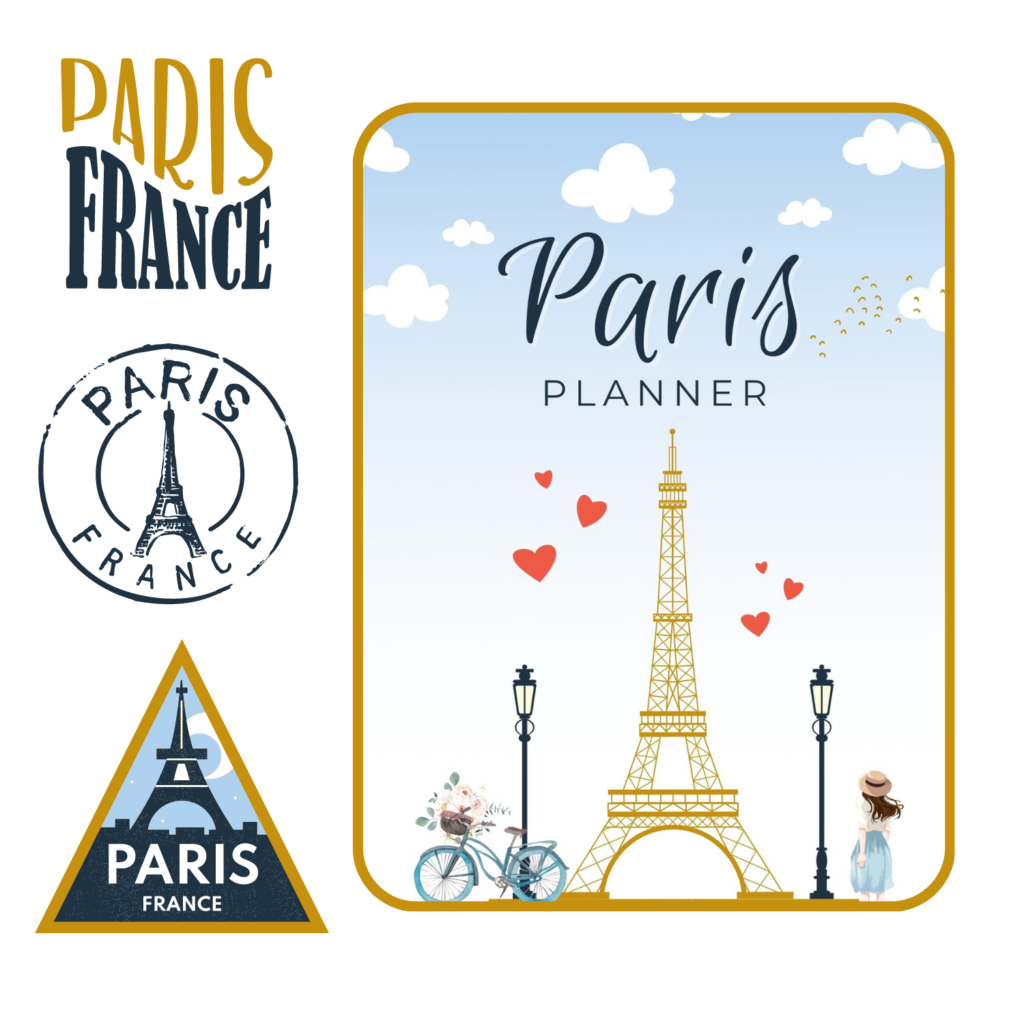
Get my FULL Paris Travel Planner with sheets for:
Trip Overview | Travel Budget | Accommodation Tracker | Transportation Tracker | Activities Planner | Pre-Trip Planning | Places to Visit | Itinerary Overview | Daily Itinerary | Arrondissement Guides | Road Trip Planning | Packing List | Outfit Planner | Expense Tracker | Souvenirs & Gifts List | To do List | January-December Planning Calendar | Paris Bucket List Checklist | and Travel Journal Pages
100 pages! Available for $9.99.
Safety tips and Do’s and Don’ts on the Paris Métro
Now that you’re a little more prepared for the Parisien metro system, it’s time to take a look at some of the safety tips while traveling. I’ve been a frequent traveler and I can honestly say that I’ve seen it all. What seems like a normal day on the Parisien metro might come as a surprise to you, so it’s essential to learn the metro etiquette before entering them.
Here are some of the things I’ve noted to help you ride the metro like a local.
Do
- During the pandemic, it is obligatory to use face-masks at all times on the trains as well as on the platforms. As of May 16, 2022 masks were no longer required (although I would advise you to wear one). This requirement could change back if the situation worsens, so you should be aware.
- Download the transit app to figure out the best ways to get around and to get updates on delays and disturbances. It also gives you access to the Paris metro map which can save you the hassle of searching for one at a station.
- Let the passengers get off the train before you get on. Once you’ve climbed on board, move to the center of the metro and don’t linger around the entrance. Almost always, you will have someone standing behind you whose way you’re blocking.
- Be aware of your surroundings. Most of the trains are equipped with speakers announcing the next station but some of them aren’t and you need to keep an eye out for your stop. On some trains, there is a light that indicates what station you are at. At some stations, you can’t just climb the stairs and cross the platform to get to the other side. You have to exit the station and re-enter (which means a new ticket!).
- Always look out for your belongings while sitting, standing, and walking on the platforms and while on the trains. It is quite common for pickpockets to steal at the ticket turnstiles, on the platform and when you’re distracted.
- Some seats are reserved for the elderly and the handicapped. Ensure you vacate those seats when necessary.
- Learn how to enter and exit the trains. Some older models have a metal handle to open and close the doors. Some have a push button, and most of the newer ones open automatically.
- Try to blend in with the locals by looking disinterested or by being engrossed in a book. This prevents you from getting into an unwanted conversation.
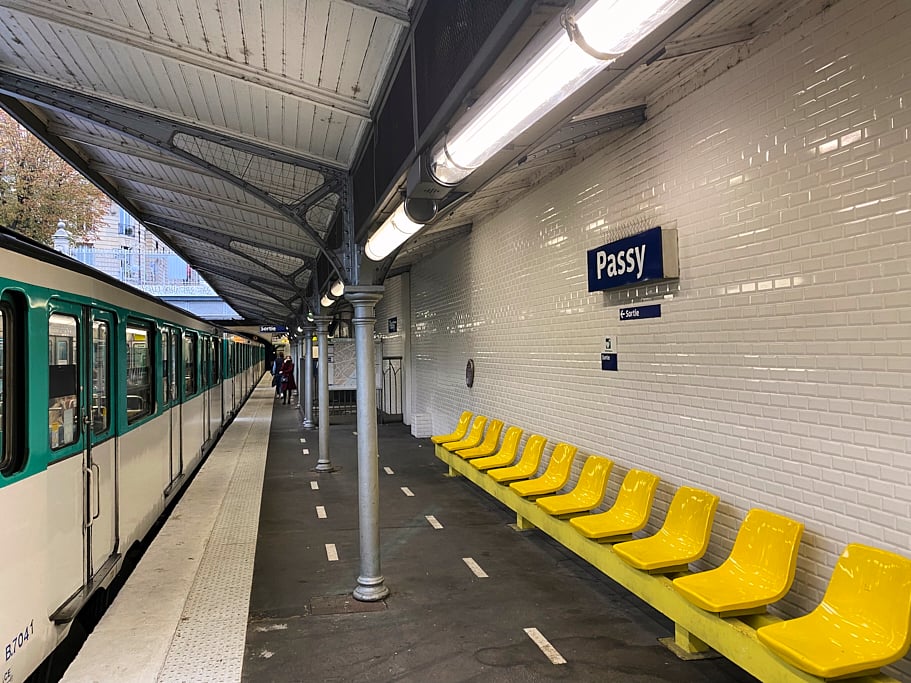
Don't
- Don't throw away your ticket before your destination. The RATP does spot checks on tickets in various stations and if you are caught without a ticket you will get a fine.
- Don’t use the seats near the doors when the metro is overflowing with travelers. Fold the seats and lean against them.
- Don’t force the automatic doors to open or close. It can not only injure you but also delay the trains and disrupt schedules.
- Don’t underestimate the speed of the trains. Hold on to something and stand. There can be sudden brakes or steep curves.
- Don’t hold on to the red lever above the doors. That’s for emergency use only, and you will be fined for improper use.
- Some trains have safety announcements about pickpockets. Do not check for your wallets as this might alert the thief and give them a map for your treasures.
- Avoid taking your phone out on the train or the platform but if you do, make sure you’re holding it tightly from all the corners as someone can easily pluck it out of your hands and run away just as the doors are closing. (I personally use this hand wrist strap while traveling.)
- Don’t make eye contact with people asking for money unless you plan on giving them some. If you make eye contact, you’re opening yourself to all kinds of crazies (and sometimes not so crazies but very rarely does that happen!).
- Some stations can get a little sketchy when the night falls. Either avoid them altogether or travel in groups. Avoid: Pigalle (on lines 2 and 12), Barbes Rouchechouart (on lines 2 and 4), Chateau Rouge (on line 4), Stalingrad (on lines 2, 5 and 7), and Colonel Fabian (on line 2).
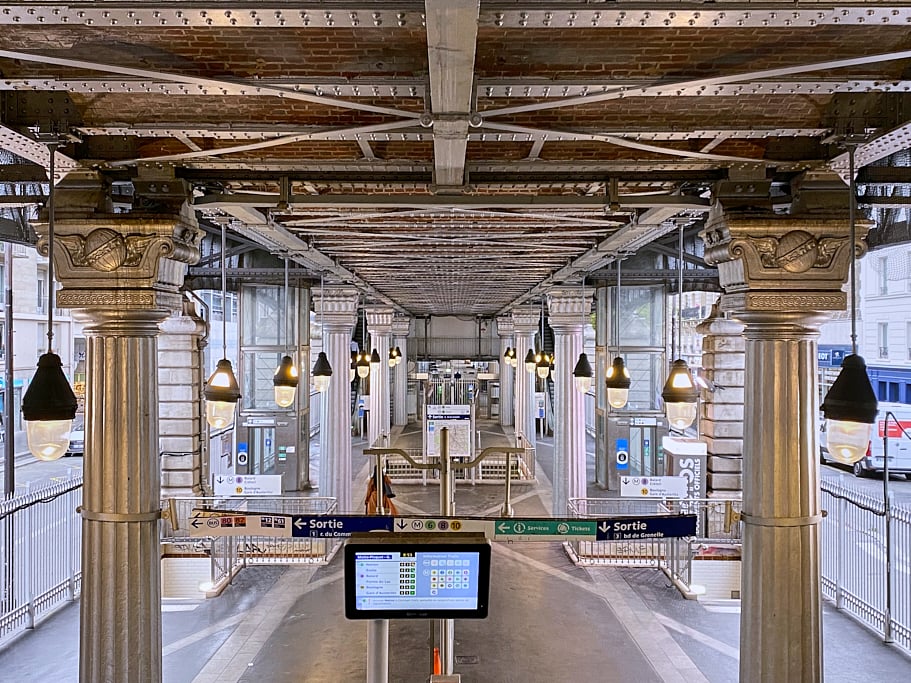
Travel Tips for the Paris Metro
Are you ready for some additional tips for traveling on the metro in Paris? I've got them!
- Just like any other public transport, the metro in Paris can malfunction. Be ready for unexpected delays or breakdowns, and have a backup plan ready.
- The French love to protest. If you hear about a transport strike or protest, keep in mind that it will affect the metros either through delays or frequency.
- Make sure you’re wearing layers. The metro can get crowded and hot and sweaty, and it is always better to peel off a layer than to stew in the trapped air.
- Most of the tourist spots are located on lines 1 and 6, like the Eiffel Tower, the Louvre Museum, the Tuileries Garden, Montparnasse, and Arc de Triomphe.
- The Châtelet station is massive and confusing! The station is now divided into 2 sectors. There is Sector Rivoli and Sector Seine. Each is marked by colored tiles. Sector Rivoli is brown with a u-shape that represents the lines of buildings on rue de Rivoli. In Sector Seine the tiles are blue with waves that represent the Seine river.
 |  |
Metro to the Airports, Disneyland and Versailles
The metro doesn’t travel to the airports. RER B, in the north, goes to CDG and Mitry Claye, whereas in the south, it goes to Antony from where you need to take the Orlyval shuttle to the Orly airport. The RER ticket to any of these airports is separate from the metro t+ ticket and does not include Orlyval. When you get off at Antony, you have to buy a separate ticket for the Orlyval shuttle.
The metro, for the most part, doesn’t go outside the Paris city limits. Versailles, or Chateau de Versailles, is in zone 3 and can be accessed by RER C going south. Disneyland Paris is in zone 5 and can be reached by RER A going to the east.

Hopefully, this guide has provided you the incentive to hop on that metro train! With preparation and tools, you can conquer the city of light and visit every corner!
Bon voyage!
How about you? Do you have other Paris metro tips to share? Do you have a Paris metro story? Do tell!
AUTHOR BIO
Andi Fisher
I am married to a French man, lived in France for 3 years, and have been to Paris more than 50 times. I am always a tourist so the information, tip, and tricks I share are created to help you!
Like it? PIN it!
 |  |  |
Tips
- Flights
- Look for fares using sites like Skyscanner or Expedia.com.
- For France (Paris) coming from the West Coast, I typically fly Air France or United. From the East Coast, I typically fly Air France or Delta.
- If you travel frequently, consider investing in a Priority Pass for airport lounge access. Not only will you have a spot to relax before your flight and charge your devices, but you can eat and drink for free (without paying crazy airport prices!)
- Accommodation
- I use Expedia.com, Booking.com, and Hotels.com to find lodging. Always check the reviews on TripAdvisor before booking!
- If you want to stay in a rental, look at VRBO and Plum Guide.
- Transportation
- For rental car agencies, try Rentalcars.com. When traveling in Europe, I use AutoEurope to make reservations. They find the best rates and allow you to compare different car rental agencies. I typically book with Sixt.
- For transportation from the CDG airport to anywhere within Paris, consider pre-booking with Get Transfer. It is one way to be stress-free and you can request an English-speaking driver.
- Tours + Atractions
- I book tours with companies like Viator and GetYourGuide. Both have a wide variety of activities for every travel style. Other companies to look at include Tours by Locals and Withlocals.
- If you’re visiting a city with multiple attractions, be sure to check out a discount pass, such as CityPASS or Go City.
- Context Travel is another option and they offer more educational-based activities.
- If you are looking to buy tickets to attractions, check out Tiquet.
- Don't Forget Travel Photos
- One of my favorite things to do is to get photos taken of me while on vacation. Flytographer is a great option with photographers all over the world.
- Peace of Mind
- It’s important to have some type of travel insurance to cover any unforeseen accidents, illnesses, threats, or cancellations. I always travel with insurance and would recommend SafetyWing, SquareMouth or Travelex Insurance are good options.
- Should you have any trouble with flight delays to the extent you feel you deserve compensation, I encourage you to check out and use AirHelp. I used them and for 1 claim I got compensated (transparency: a 2nd claim did not, but I was still glad I tried!).
- Planning
- Check out Le Shop for my digital travel planners and Paris planner!



I need this guide. I’ll definitely get lost when I do get the chance to explore Paris for the first time.
I will be keeping this in mind. We will be in Paris in July and I don’t want to get lost.
That was an interesting read. I’ve never been to Paris so didn’t know what their metro was like. Always nice to be aware.
Not growing up being able to have access to a metro system so thank you for the education! There is more involved with then than I realized.
An app for the metro is such a good idea! I remember as a kid watching my dad try to figure it out when we were visiting Paris.
Sounds like a great way to get around. The Metro station looks very clean.
I’ve found this post really helpful, thanks for sharing these tips.
Public transportation is so intimidating!!! Especially when experiencing it away from home! Thank you for such a detailed breakdown on how to navigate the Paris Metro!
This is a really great and very helpful post! This is so informative! Thanks for sharing this with us!
There is so much useful information here for using the metro to visit paris. The perfect guide for travelers!
The only metro system I had to try and navigate was in NYC and it was so confusing. If I go to Paris I’ll have my French speaking husband with me so that’ll help!
I remember taking the metro when I was traveling to the airport, on my return trip to fla. I remember that it was a little difficult to navigate. But i was glad my kids were there to help me.
When I go abroad visiting a new city, the first thing I am looking for is how the public transport works. Thanks for these important details!
It’s great that there are apps now to help us navigate. No more carrying maps.
This is such a helpful guide! I have bookmarked this page 😍
What a neat metro system. It was interesting to learn about how it works. I’ve never been to Paris and would love to go someday.